#Vitaly Komar
Text

Vitaly Komar — Caution Is Not Cowardice (oil, canvas laid on board, 1972)
418 notes
·
View notes
Text
Vitaly Komar and Alexander Melamid
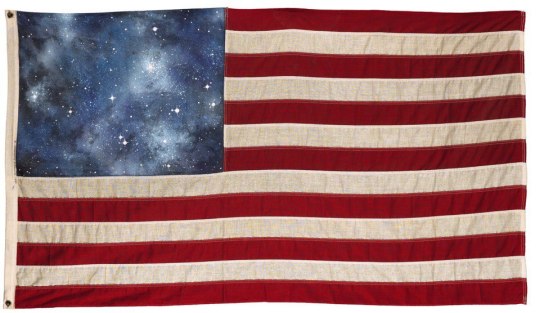
#Комар и Меламид#Vitaly Komar#Alexander Melamid#art#russian art#conceptual art#us flag#contemporary art
2 notes
·
View notes
Text
13 notes
·
View notes
Text
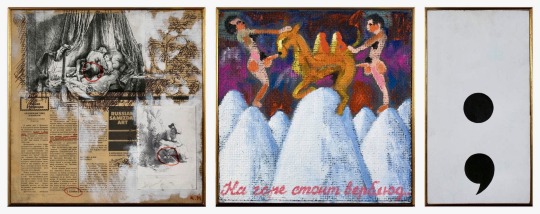
Vitaly Komar, Alexander Melamid
Response to a Russian Art Critic (triptych), 1984-87
oil, collage, mixed media on canvas on plywood
Vladey
7 notes
·
View notes
Text

Das römische Bild
1.
Auf den Punkt gebracht, beziehungsweise auf (Umriss-)Linie gehalten: Vitaly Komars and Alexander Melamids Geburt des sozialistischen Realismus aus dem Geist eines (Klage-)Begehrens, das einer Leere, einer Abwesenheit und einem Abgrund aufsitzen soll. Man kann sagen, dass dieses Bild zu den Kunstwerken gehört, aus denen heraus Aby Warburg seinen hohem Berufsbezeichungsverbrauch entwickelt. Das ist nämlich ein Bild, von dem Aby Warburg den Eindruck gehabt haben könnte, dass da etwas nicht mit stimmt, oder aber dass er dachte, dass Bilder doch auch eine andere Aufgabe und eine Funktion haben, als Gründe über Abgründen einzuziehen, als eine Abwesenheit abzuschirmen, indem man einen Stellvertreter beschirmt. Haben Bildern nicht auch die Aufgabe, Verkehr und Verzehr zu ermöglichen, sollen sie nicht auch etwas (ver-)brauchen lassen, vielleicht sogar sollen sie einfach Brauch lassen, die Waren- und Menschenströme begleiten lassen, indem sie etwas davon verwalten lassen, ohne eine große Referenz zu sichern??
2.
Es kann ja sein, dass der sozialistische Realismus in dem gezeigten Moment geboren wurde. Vielleicht wurde in entsprechenden Momenten sogar der politische Realismus und sogar noch der römische Realismus geboren. Vielleicht wurde das alles sogar so geboren, dass Lacan noch in seinem Vortrag in Rom [!] daraus Bausteine eines römischen Realismus entwickeln konnte, der nicht nur aus realistischen Dingen, sondern aus Symbolischem, Imaginärem und Realem sich zusammensetzt, um ein wahres oder zumindest gut analysiertes und gut analysierbares Bild vom Menschen zu geben oder gar, wie Legendre behauptet, ihm eine Instanz zu garantieren.
Wenn das alles so geboren wurde und dann sogar Berufe daran anschlossen, um das zu erklären, weiterzugeben, zu verbessern, dann müsste sich eben Aby Warburg einen neuen Berufsuchen, einen Beruf für andere Bilder, die in anderen Momenten geboren wurden oder die gar nicht geboren wurden. Zumindest interessiert sich Aby Warburg prinzipiell für Bilder, die bewegen und bewegt sind und in deren Bewegung Achsen und Ellipsen, insofern schon Polarität im Spiel ist, die also etwas so kehren lassen, dass die Umkehr darin so unsicher und ungesichert ist, wie die Wiederkehr. Selbst wenn oder gerade weil diese Kehren vom "Dämon des Selben" (Foucault) besetzt sind oder begleitet werden, bleiben sie für Warburg auf ungesicherten, unsicheren Routen. Sternenbilder mit ihrer Magie (ihrem Zuviel), mit ihrem Minus (ihrer minderen Gesetzlichkeit und minderen Normativität) beschäftigen Warburg zumindest mehr, länger und intensiver als die Tradition einer Ikonographie, die der großen Trennung von Abwesenheit und Anwesenheit, von Gründen und Abgründen aufsitzt.
3.
Wie Lefort, so hat auch Aby Warburg einen Sinn für etwas, was jedem Realismus vorgeht und das Lefort als mise-en-forme bezeichnet. Die Übersetzer Leforts nennen das teilweise Formgebung, teilweise In-Form-Setzen. Falls Lefort mit diesem Begriff etwas von der Sensibilität Warburgs teilt, dann könnte man auch von Bildgebung, von einem Ins-Bild-Setzen, Ins-Bild-Kippen oder vielleicht sogar einem Vor-Augen-Laden sprechen. Die Art und Weise, wie damit einsetzt, was 'instituiert' (Vismann) oder aber eine 'institutionelle Macht' (Descombe/Vesting) entfalten soll, das lässt sich auf Warburgs Staatstafeln auch über Leere und Negativität beschreiben, eber nur schwer über glatte Leere und reine Negativität. Was daran mit Alterität zu tun hat, hat bei Warburg auch mit Archäologie, also auch mit Altern im Sinne einer aufgehäuften oder aufgeschichteten, einer gefalteten und in gewisser Hinsicht diplomatischen Zeit zu tun.
7 notes
·
View notes
Link
#this was a good yet sad read#especially when you think about it on a more global scale#i get that there's a certain aes for new LA coffee shops#but hearing that it's not just LA is just...well it's sad and not all that surprising at once
2 notes
·
View notes
Link
This is why it’s important to get out there and look for something new and interesting. Touch grass, read old books, talk to old people, try something new.
3 notes
·
View notes
Text
Independent Research: Performance and Conceptual Art 1980-1990s
In class we were split into research groups and we given the topic of conceptual art post 1990 to research and discuss, and I found it particularly interesting so I have decided to expand on this, extending to reflect on performance art as this is a topic I would like to further my knowledge in. I have chosen four artists who's work I have a personal interest in and have futher discussed with my group, and will be analysing their practise, place within and significance to conceptual and contemporary art. First beginning by discussing the work of Cuban artist Ana Mendieta and her practise and approach to performance art in the 80s following her Silueta Series. Then looking at the work of Marina Abramovic and her many years of conceptual performance pieces, also exploring body art. And finally I will be discussing Moscow conceptualists Alexander Melamid and Vitaly Komar, who have collaborated on multiple projects surrounding themes of their experience living in the oppressive Soviet Union.
Ana Mendieta's practise revolves around 'earth-body works' as she is concerned with themes of the female body, death, transformation and cultural displacement with a connection to Cuba. She often used the ritualistic tones that are seen in Cuban religious practises, through the symbols of blood, air, water and fire. This can be seen most prominently in her famous Silueta series (1973-1980). Mendieta was greatly interested in feminist art practises in the early 80s, as she continued to explore the emotional connection between her body and the natural world. For example with her Amategram series - Vivification of flesh in 1981. Totem-like forms painted with black acrylic onto Amate, paper made from bark by Otomi Craftspeople in Mexico. Further emphasising Mendieta's engagement with the body and earth. Again linking with rituals and offerings in her symbolic mark making process. Another artwork that follows this is Nile Born (1984) a sculpture created out of sand, laid on a wooden base and shaped to scale Mendieta's body. This artwork is about re-establishing bonds between the artists home country after being exiled and living in America, the artwork serves as a symbol for women.
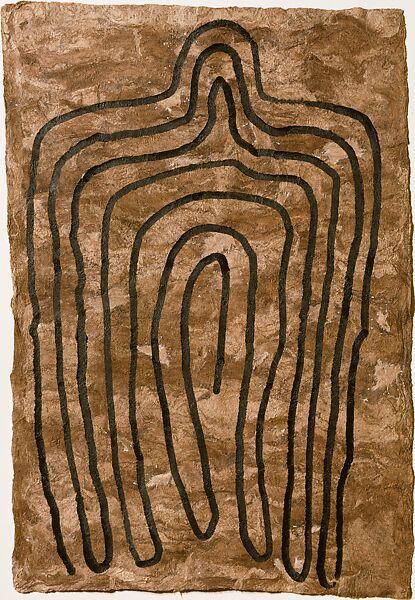
Marina Abramovic is a pioneer in utilising performance as a visual art form, she explores the physical and mental limits of her being with her practise, the body is both her subject and medium. Abramovic has endured, pain, danger and exhaustion for emotional transformation. One example of this is her piece Rest Energy (1980) a collaborative artwork with the artist's long term partner, Ulay. One arrow is held on the weight of their body, the arrow pointing at Abramovic's heart with microphones recording their heartbeats which became more intense as the performance progressed. The performance was completely dependant on trust. Another artwork I found very interesting due to the use of digital media and the idea of repetition of an act was Cleaning the mirror (1995) of which 5 monitors were stacked on top of each other and played videos of a performance where Abramovic scrubs a human skeleton covered in dirt in her lap, the ritual of becoming one with your own mortality - a Tibetan death rite, the action lasted three hours.
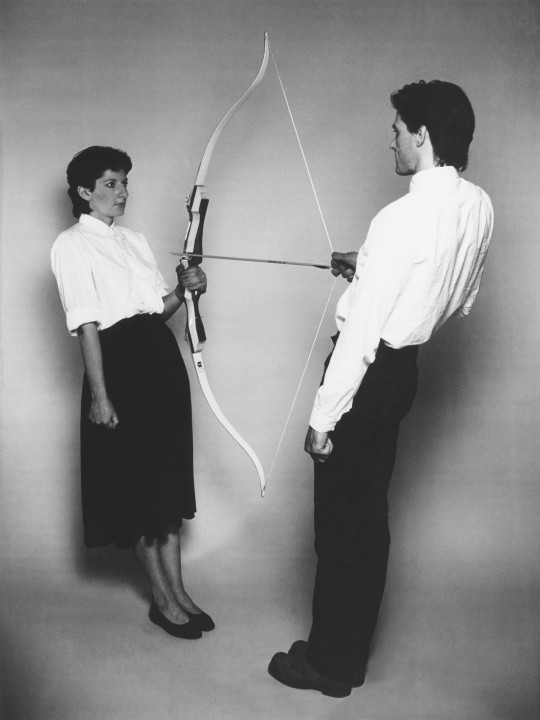
Artists Alexander Melimid and Vitaly Komar were two leading conceptualists in Moscow. Their work ranges from painting and sculpture to performance pieces and they have worked with a variety of mediums. The artists first met in 1963 as students at the Stroganov Institute of Art and Design in Moscow and began collaborating in 1965. They were expelled from the Moscow union of artists after participating in many avant-garde exhibitions and emigrated to Israel in 1977 before moving to New York a year later. Their work continued to critique the totalitarian regime they were brought up in. They created a series of artworks between 1980-83 named The Nostalgic Socialist Realism series, Melimid and Komar made ironic commentaries on the propaganda of communism, that mimicked the subjects and style of official art, they satirize art history. Blindman's Buff in particular is interesting stands out in this series as although the subject is seemingly light hearted, the tone of the painting is clear, with the drab colours, as well as the picture of Stalin bathed in red displayed on the wall.
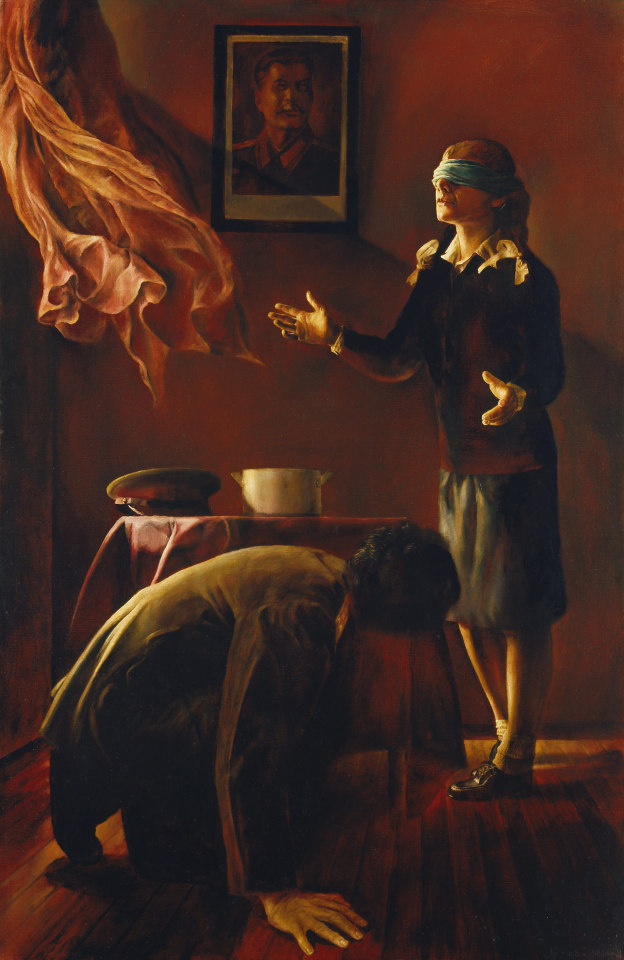
Bibliography
Demaria, C., 2004. The performative body of Marina Abramović: rerelating (in) time and space. European Journal of Women's Studies, 11(3), pp.295-307. The Performative Body of Marina Abramović: Rerelating (in) Time and Space - Cristina Demaria, 2004 (sagepub.com)
Hillings, V.L., 1999. Komar and Melamid's Dialogue with (Art) History. Art Journal, 58(4), pp.48-61. Komar and Melamid's Dialogue with (Art) History: Art Journal: Vol 58, No 4 (tandfonline.com)
Roulet, L., 2012. Ana Mendieta as Cultural Connector with Cuba. American Art, 26(2), pp.21-27. https://www.journals.uchicago.edu/doi/full/10.1086/667947
Wollen, P., 1991. Scenes from the future: Komar & Melamid. New Left Review, 185, pp.68-80. Peter Wollen, Scenes from the Future: Komar & Melamid, NLR I/185, January–February 1991 (newleftreview.org)
0 notes
Text
0 notes
Text
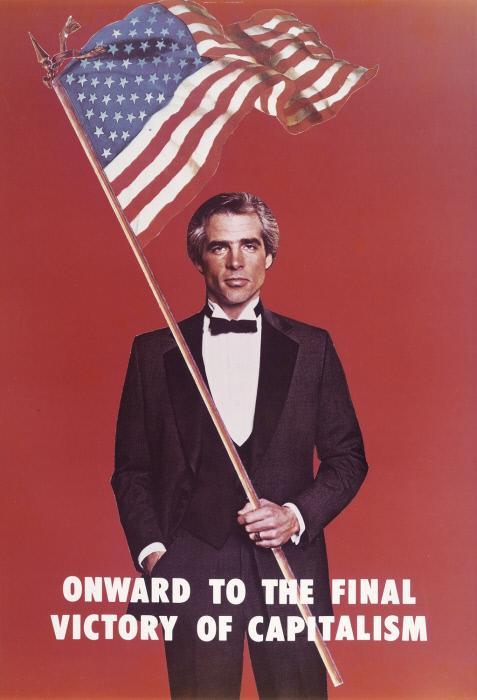
Artist Vitaly Komar (Born in Moscow, Russia (formerly the USSR), 1943)
Artist Alexander Melamid (Born in Moscow, Russia (formerly the USSR), 1945)
0 notes
Text
vimeo
On January 10th 2022 an online-conversation with philosopher, essayist, art critic and media theorist Boris Groys took place. During the conversation Boris Groys debated the issues raised by the novel installation Matter, Non-Matter, Anti-Matter which showcases digital models of past exhibitions on a custom-made display, also using Augmented Reality. The conversation was moderated by Corina L. Apostol, curator at Tallinn Art Hall, and artist and writer Kristaps Ancāns.
The conversation centred around the AR interpretation of the artworks Project for the modification of a monument from the Communist era (1999, computer-assisted drawing, 28 × 21.6 cm, private collection) and Untitled Installation (Statue Dangling from a Crane) (2002, communist monument, crane) by Vitaly Komar and Alexander Melamid. The original artworks were first exhibited in the context of the exhibition Iconoclash. Beyond the Image Wars in Science, Religion and Art that took place in ZKM | Karlsruhe in 2002.
The exhibition Matter, Non-Matter, Anti-Matter. Past Exhibitions as Digital Experiences presented the digital models of two past exhibitions, where AR Statue Dangling from a Crane was on display among many other artworks at the Tallinn Art Hall from 10 November 2021 until 16 January 2022. This exhibition was part of the large-scale cooperation project BEYOND MATTER – Cultural Heritage on the Verge of Virtual Reality, co-funded by the Creative Europe Programme of the European Union and German Federal Government Commissioner for Culture and the Media.
0 notes
Text

Vitaly Komar — Quotation (oil and canvas mounted on board, 1971)
64 notes
·
View notes
Text

Vitaly Komar and Alexander Melamid
#Vitaly Komar and Alexander Melamid#Комар и Меламид#art#conceptual art#soviet art#graphic#say something#contemporary art
25 notes
·
View notes
Text
Soviet Pop Art Duo Reunites for First U.S. Retrospective Since Their Breakup
The rebellious artists Vitaly Komar and Alexander Melamid founded their own artistic movement. They agreed to their first interview together in 20 years.
source https://www.nytimes.com/2023/04/26/arts/komar-melamid-zimmerli.html
View On WordPress
0 notes
Link

“We have been travelling to different countries, engaging in dull negotiations with representatives of polling companies, raising money for further polls, receiving more or less the same results, and painting more or less the same blue landscapes. Looking for freedom, we found slavery.”
A nice walkthrough of several reversions to the mean.
0 notes